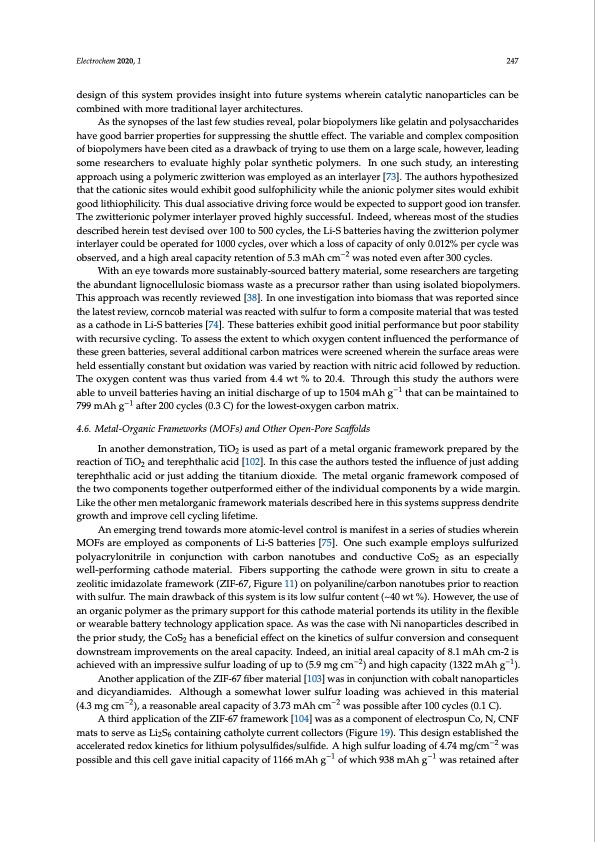
PDF Publication Title:
Text from PDF Page: 022
Electrochem 2020, 1 247 design of this system provides insight into future systems wherein catalytic nanoparticles can be combined with more traditional layer architectures. As the synopses of the last few studies reveal, polar biopolymers like gelatin and polysaccharides have good barrier properties for suppressing the shuttle effect. The variable and complex composition of biopolymers have been cited as a drawback of trying to use them on a large scale, however, leading some researchers to evaluate highly polar synthetic polymers. In one such study, an interesting approach using a polymeric zwitterion was employed as an interlayer [73]. The authors hypothesized that the cationic sites would exhibit good sulfophilicity while the anionic polymer sites would exhibit good lithiophilicity. This dual associative driving force would be expected to support good ion transfer. The zwitterionic polymer interlayer proved highly successful. Indeed, whereas most of the studies described herein test devised over 100 to 500 cycles, the Li-S batteries having the zwitterion polymer interlayer could be operated for 1000 cycles, over which a loss of capacity of only 0.012% per cycle was observed, and a high areal capacity retention of 5.3 mAh cm−2 was noted even after 300 cycles. With an eye towards more sustainably-sourced battery material, some researchers are targeting the abundant lignocellulosic biomass waste as a precursor rather than using isolated biopolymers. This approach was recently reviewed [38]. In one investigation into biomass that was reported since the latest review, corncob material was reacted with sulfur to form a composite material that was tested as a cathode in Li-S batteries [74]. These batteries exhibit good initial performance but poor stability with recursive cycling. To assess the extent to which oxygen content influenced the performance of these green batteries, several additional carbon matrices were screened wherein the surface areas were held essentially constant but oxidation was varied by reaction with nitric acid followed by reduction. The oxygen content was thus varied from 4.4 wt % to 20.4. Through this study the authors were able to unveil batteries having an initial discharge of up to 1504 mAh g−1 that can be maintained to 799 mAh g−1 after 200 cycles (0.3 C) for the lowest-oxygen carbon matrix. 4.6. Metal-Organic Frameworks (MOFs) and Other Open-Pore Scaffolds In another demonstration, TiO2 is used as part of a metal organic framework prepared by the reaction of TiO2 and terephthalic acid [102]. In this case the authors tested the influence of just adding terephthalic acid or just adding the titanium dioxide. The metal organic framework composed of the two components together outperformed either of the individual components by a wide margin. Like the other men metalorganic framework materials described here in this systems suppress dendrite growth and improve cell cycling lifetime. An emerging trend towards more atomic-level control is manifest in a series of studies wherein MOFs are employed as components of Li-S batteries [75]. One such example employs sulfurized polyacrylonitrile in conjunction with carbon nanotubes and conductive CoS2 as an especially well-performing cathode material. Fibers supporting the cathode were grown in situ to create a zeolitic imidazolate framework (ZIF-67, Figure 11) on polyaniline/carbon nanotubes prior to reaction with sulfur. The main drawback of this system is its low sulfur content (~40 wt %). However, the use of an organic polymer as the primary support for this cathode material portends its utility in the flexible or wearable battery technology application space. As was the case with Ni nanoparticles described in the prior study, the CoS2 has a beneficial effect on the kinetics of sulfur conversion and consequent downstream improvements on the areal capacity. Indeed, an initial areal capacity of 8.1 mAh cm-2 is achieved with an impressive sulfur loading of up to (5.9 mg cm−2) and high capacity (1322 mAh g−1). Another application of the ZIF-67 fiber material [103] was in conjunction with cobalt nanoparticles and dicyandiamides. Although a somewhat lower sulfur loading was achieved in this material (4.3 mg cm−2), a reasonable areal capacity of 3.73 mAh cm−2 was possible after 100 cycles (0.1 C). A third application of the ZIF-67 framework [104] was as a component of electrospun Co, N, CNF mats to serve as Li2S6 containing catholyte current collectors (Figure 19). This design established the accelerated redox kinetics for lithium polysulfides/sulfide. A high sulfur loading of 4.74 mg/cm−2 was possible and this cell gave initial capacity of 1166 mAh g−1 of which 938 mAh g−1 was retained afterPDF Image | Lithium-Sulfur Batteries: Advances and Trends

PDF Search Title:
Lithium-Sulfur Batteries: Advances and TrendsOriginal File Name Searched:
electrochem-01-00016.pdfDIY PDF Search: Google It | Yahoo | Bing
Sulfur Deposition on Carbon Nanofibers using Supercritical CO2 Sulfur Deposition on Carbon Nanofibers using Supercritical CO2. Gamma sulfur also known as mother of pearl sulfur and nacreous sulfur... More Info
CO2 Organic Rankine Cycle Experimenter Platform The supercritical CO2 phase change system is both a heat pump and organic rankine cycle which can be used for those purposes and as a supercritical extractor for advanced subcritical and supercritical extraction technology. Uses include producing nanoparticles, precious metal CO2 extraction, lithium battery recycling, and other applications... More Info
| CONTACT TEL: 608-238-6001 Email: greg@infinityturbine.com | RSS | AMP |